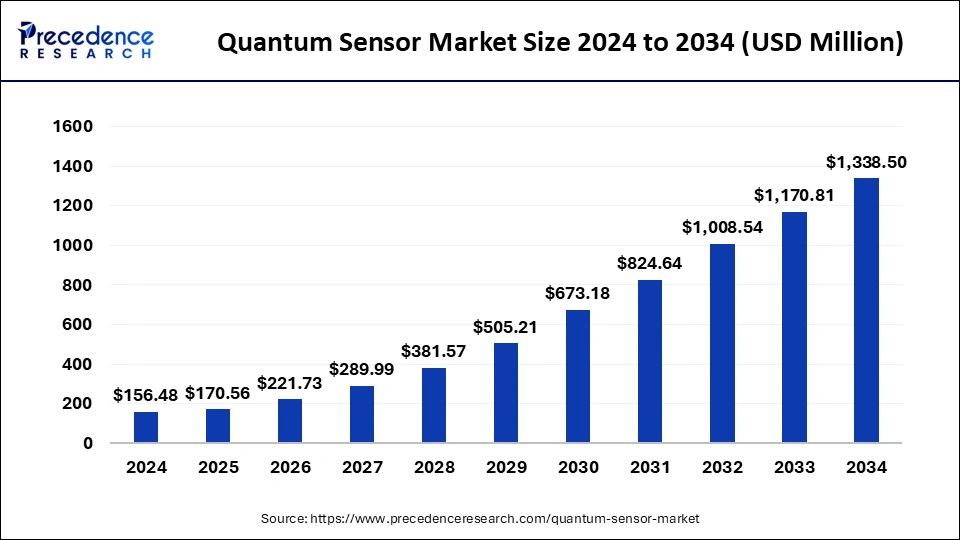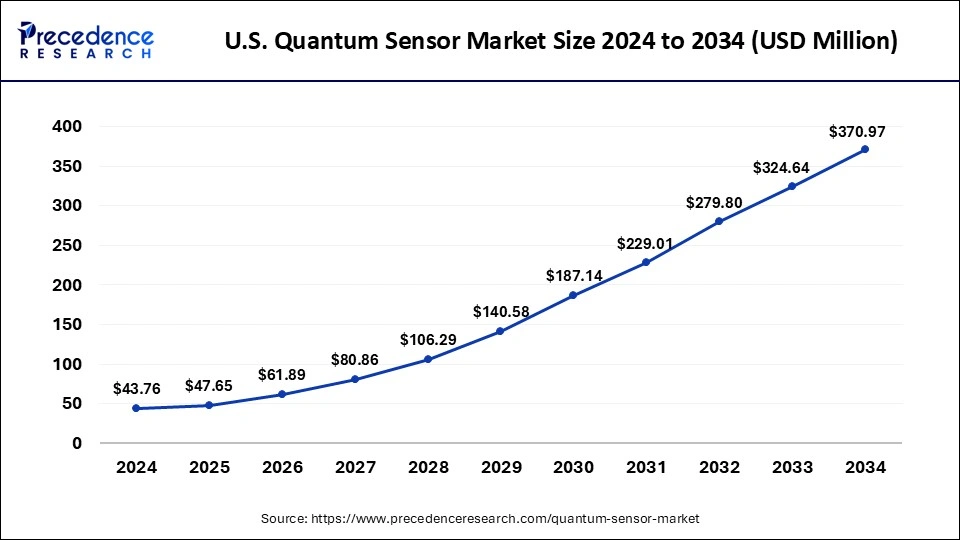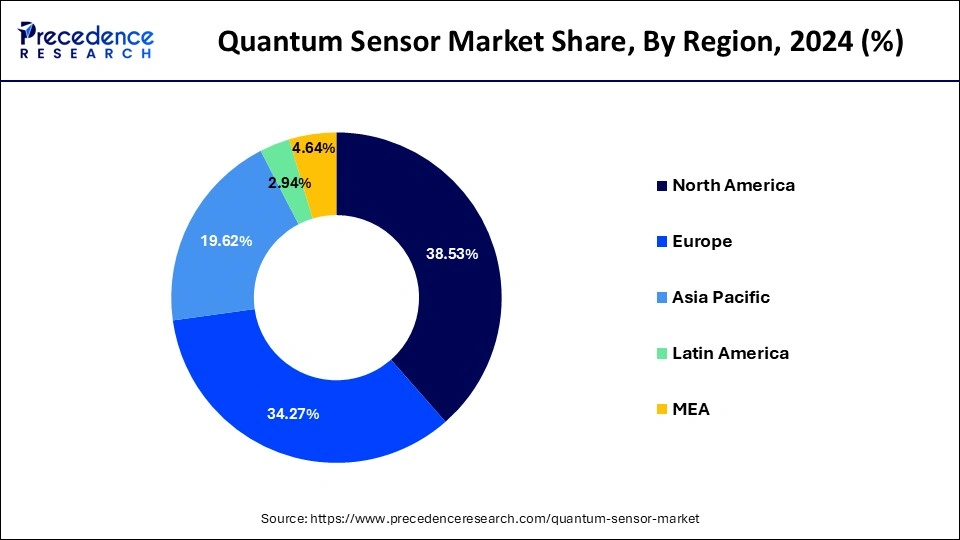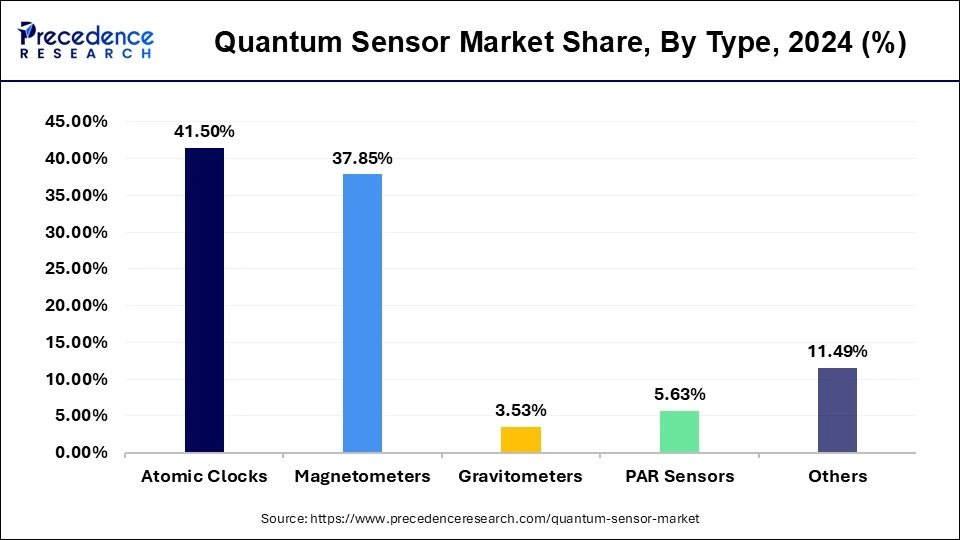Quantum Sensor Market Size and Forecast 2025 to 2034
The global quantum sensor market size was estimated at USD 156.48 million in 2024 and is predicted to increase from USD 170.56 million in 2025 to approximately USD 1,338.50 million by 2034, expanding at a CAGR of 25.70% from 2025 to 2034.

Quantum Sensor MarketKey Takeaways
- In terms of revenue, the global quantum sensor market was valued at USD 156.48 million in 2024.
- It is projected to reach USD 1,338.50 million by 2034.
- The market is expected to grow at a CAGR of 25.70% from 2025 to 2034.
- North America dominated the market with the largest share of 38.53% in 2024.
- Europe is observed to witness the fastest rate of growth during the forecast period.
- Asia Pacfic is observed to witness a significant growth in the predicted timeframe.
- By type, the atomic clocks segment held the dominating share of 41.50% in 2024.
- By type, the others segment is expected to witness the fastest rate of expansion during the forecast period.
- By application, the others segment held the largest share of 62.15% in 2024.
- By application, the magnetic field sensing segment held the second largest share while contributing for 37.85% in 2024.
- By end-user, the navigation and transportation segment held the largest share of the market in 2024.
- By end-user, the healthcare segment is observed to expand at the fastest pace during the forecast period.
U.S. Quantum Sensor Market Size and Growth 2025 to 2034
The U.S. quantum sensor market size was exhibited at USD 43.76 million in 2024 and is projected to be worth around USD 370.97 million by 2034, growing at a CAGR of 25.60% from 2025 to 2034.

North America held the largest share of the quantum sensors market contributing to 38.53% market share in 2024. North America is home to several key industry players and technology hubs specializing in quantum sensing technologies. Companies such as Honeywell International Inc., Lockheed Martin Corporation, and QuEra Computing Inc. are headquartered or have significant operations in North America, contributing to the region's dominance in the quantum sensors market. These companies have the expertise, resources, and infrastructure to develop and commercialize advanced quantum sensing solutions for diverse applications.
Europe is observed to grow at the fastest pace during the forecast period of 2024-2033. Europe has invested much in and demonstrated a keen interest in quantum technologies, particularly quantum sensors. The quantum flagship program of the European Union aims to establish Europe as a leader in quantum technology worldwide. A sizeable €1 billion has been set aside for the quantum flagship initiative over ten years (2018–2028). Additionally, businesses in Europe are investigating the use of quantum sensors in the energy, telecommunications, and automobile industries.

The quantum sensors market is showing significant growth in Asia Pacific. Countries like China, Japan, and South Korea have spent heavily on quantum research and development. Quantum technologies have been extensively promoted by China. For instance, the Quantum Scientific Satellite (QSS), sometimes called Micius, is a Chinese satellite mission dedicated to quantum scientific experiments and quantum communication that was launched by the Chinese government. Using the phenomena of quantum entanglement, the primary goal of the QSS mission is to allow long-distance quantum communication. During the anticipated years, these elements are observed to drive the regional market.
Market Overview
The quantum sensors market offers devices that leverage principles from quantum mechanics to measure physical quantities with high precision and sensitivity. Quantum mechanics is a branch of physics that describes the behavior of matter and energy at the smallest scales, typically at the level of atoms and subatomic particles. Quantum sensors use the unique properties of quantum systems to enhance their performance in measuring various physical parameters.
Quantum sensors can measure magnetic fields with exceptional sensitivity, enabling applications in geological exploration, magnetic resonance imaging (MRI), navigation systems, and detection of magnetic anomalies. Quantum sensors enable high-resolution imaging techniques, such as quantum-enhanced imaging and quantum ghost imaging, which find applications in biomedical imaging, security screening, and surveillance.
Quantum Sensor Market Growth Factors
- The increasing demand for high-precision measurement devices is expected to propel the quantum sensors market over the forecast period. Quantum sensors offer unparalleled precision in measuring physical quantities such as time, magnetic fields, and gravitational forces. As industries and research fields demand higher levels of accuracy in their measurements, the demand for quantum sensors has been growing.
- Governments, private companies, and research institutions have been increasing their investments in quantum research and development. These investments aim to explore and harness the potential of quantum technologies, including quantum sensors, for practical applications.
- Growing applications in the healthcare industry are expected to offer a lucrative opportunity for market growth. Quantum sensors are finding applications in healthcare, such as in the development of more accurate medical imaging devices. The potential for early disease detection and improved diagnostic capabilities is driving interest in the use of quantum sensors in the healthcare sector.
Market Scope
| Report Coverage | Details |
| Growth Rate from 2025 to 2034 | CAGR of 25.70% |
| Market Size in 2025 | USD 170.56Million |
| Market Size by 2034 | USD 1,338.50 Million |
| Base Year | 2024 |
| Forecast Period | 2025 to 2034 |
| Segments Covered | Type, Application, and End-user |
| Regions Covered | North America, Europe, Asia-Pacific, Latin America, and Middle East & Africa |
Market Dynamics
Driver
Growing demand for secure communication
The increasing use of quantum sensors is being driven by the need for secure communication networks, particularly in the field of quantum cryptography. These advanced sensors have the potential to completely transform encryption techniques, rendering them essentially unbreakable. To provide very secure communication channels, quantum cryptography makes use of the concepts of quantum physics. This is made possible by quantum sensors, which make it possible to monitor and identify quantum events like quantum key distribution and entangled particles. These features make it possible to create unbreakable encryption techniques, which are crucial for protecting sensitive data.
Quantum sensors have attracted a lot of interest globally as governments and businesses realize how crucial secure communications are. They are in a leading position to protect data security and privacy in an increasingly related world because of their capacity to utilize the special qualities of quantum physics. The quantum sensors market is growing as a result of the growing demand for secure communication networks, particularly in the area of quantum cryptography.
Restraint
Commercialization of products
One of the biggest obstacles is the lengthy procedure of every new product's market introduction. While industry players are working on several research projects and creating new technologies, product commercialization is moving relatively slowly. For instance, the NV Color Center has successfully enabled researchers to manufacture quantum sensors, but the market has not yet seen the practical effect of this finding in any application. Persuading supporting organizations and institutions about the advantages of quantum technology is another factor contributing to the market's late adoption.
The current institutional funding, employment, and promotion strategies are not keeping up with the fast advancement of quantum technology. During the projection period, the aforementioned concerns will impede the expansion of quantum sensors market.
Opportunity
Technological advancements
Sensor measurements have been greatly influenced by ongoing improvements in this sector, such as better quantum coherence times and greater qubit management. These developments have improved sensor technology's sensitivity and accuracy, providing a notable performance improvement. Significant progress has been made in understanding quantum coherence times, or the amount of time that quantum states may be sustained. Data collecting is now more accurate and trustworthy because of this improved coherence. Thereby, such technological advancements are observed to open lucrative opportunities for the quantum sensors market in the upcoming years.
Additionally, more accurate and complex sensor designs have been made possible by improved control over qubits, the basic building blocks of quantum information. The increasing requirement for high-precision measurements in a variety of areas, including healthcare, defense, and environmental monitoring, is driving up demand for quantum sensors.
Type Insights
The atomic clocks segment dominated the quantum sensors market with 41.62% of the market share in 2024. The segment dominance is attributed to the increase in funding from various nations. These clocks rely on the vibrations of atoms, typically cesium or rubidium atoms, to generate highly accurate and stable time references. By harnessing the quantum properties of atoms, atomic clocks can achieve remarkable levels of precision, making them indispensable tools in various scientific, navigational, and technological endeavors.
- For instance, in June 2023, the world's first quantum information firm, Infleqtion, revealed that it has received funding from Innovate UK to increase the capacity of its manufacturing for systems with quantum capabilities. With the help of this funding, a new kind of optical atomic clock will be developed that will considerably outperform the present GNSS-based systems in terms of precision and reliability.

The others segment is observed to witness the fastest rate of expansion during the forecast period. This segment encompasses a variety of sensors aligned with technologies. Their versatility allows them to be utilized in diverse applications across multiple industries, including healthcare, environmental monitoring, industrial automation, and defense. This flexibility makes them highly sought after by companies and research institutions seeking innovative sensor solutions for niche applications or emerging technologies.
The quantum magnetic sensors segment will witness a notable growth rate in the predicted timeframe. Quantum magnetic sensors, based on principles such as superposition and entanglement, offer significantly higher sensitivity and precision compared to traditional magnetic sensors. This makes them valuable for applications requiring accurate measurements of magnetic fields.
Moreover, quantum magnetic sensors find applications in medical imaging, particularly in magnetoencephalography (MEG) and magnetocardiography (MCG). These sensors can detect weak magnetic fields generated by the human body, providing non-invasive methods for studying brain and heart activity. Thereby driving the quantum sensors market's growth over the forecast period.
Application Insights
The others segment held the dominating share of 62.15% in 2024. This segment includes niche or emerging applications that leverage the unique capabilities of quantum sensors, including environmental monitoring, agriculture, geophysics, space exploration, and quantum information processing. The versatility of quantum sensors allows them to address diverse needs across multiple industries and scientific disciplines, driving demand from various end-users.
The magnetic field sensing segment held the second largest share while holding 37.85% market share in 2024. Magnetic field sensing is essential in various industries and research fields, including geophysics, aerospace, defense, healthcare, and environmental monitoring. Quantum sensors are utilized in magnetic resonance imaging (MRI) machines, navigation systems, magnetic anomaly detection, geological surveys, and magnetic field mapping, among other applications. Their versatility and accuracy make them indispensable tools in scientific research, industrial processes, and technological innovations.
Global Quantum Sensors Market Revenue, By Application (USD Million), 2022-2024
| Application | 2022 | 2023 | 2024 |
| Magnetic Field Sensing | 54.55 | 56.46 | 59.23 |
| Others | 89.29 | 92.56 | 97.26 |
End-user Insights
The navigation and transportation segment dominated the quantum sensors market in 2024. Quantum sensors offer unprecedented levels of precision and accuracy, making them ideal for applications in navigation systems. Quantum gyroscopes and accelerometers, for example, can provide highly accurate measurements of rotation and acceleration, enabling the development of advanced navigation systems for aircraft, ships, autonomous vehicles, and satellites.
The healthcare segment is observed to expand at the rapid pace in the quantum sensors market during the forecast period. It is anticipated that continued technical developments in quantum sensing will spur additional innovation and use of these sensors in the medical field, improving patient care and diagnosis. For instance, quantum sensors are essential to magnetic resonance imaging technologies. One kind of quantum sensor used to identify and quantify the weak magnetic fields produced by the body's tissues is the Superconducting Quantum Interference Device (SQUID). This makes it possible to produce intricate, high-resolution pictures that are used to diagnose and track a variety of medical disorders.
The automotive segment is observed to grow at a notable rate. In automobile applications, quantum sensors with great sensitivity to magnetic fields can be used, including magnetometers built on atomic or superconducting technology. Applications such as compasses, metallic object recognition, and collision avoidance systems are made possible by these sensors' ability to sense and quantify the Earth's magnetic field as well as the magnetic fields produced by surrounding objects.
Furthermore, these sensors can support automobile environmental monitoring. Quantum sensors are capable of detecting and measuring various air pollutants, such as volatile organic compounds (VOCs) and nitrogen oxides (NOx). Real-time air quality data may be obtained by integrating these sensors into cars, enabling more efficient pollution management as well as enhanced passenger health and safety.
Global Quantum Sensors Market Revenue, By End User (USD Million), 2022-2024
| End User | 2022 | 2023 | 2024 |
| Healthcare | 31.52 | 32.59 | 34.15 |
| Defense & Intelligence | 12.97 | 13.45 | 14.14 |
| Construction & Mining | 5.99 | 6.18 | 6.47 |
| Energy & Oil & Gas | 5.39 | 5.55 | 5.78 |
| Agriculture | 21.75 | 22.62 | 23.85 |
| Navigation & Transportation | 43.76 | 45.65 | 48.27 |
| Others | 22.46 | 22.98 | 23.82 |
Recent Developments
- In November 2023, Munich-based QuantumDiamonds, a startup in quantum sensing, reported that they had raised USD 7.54 million in early money. The fundraising was spearheaded by €3 million from UK-based venture capital firm VC IQ Capital and pan-European venture capital firm Earlybird, known for their investments in N26 and UiPath. Onsight Ventures, First Momentum, Creator Fund, UnternehmerTUM, and several angel investors from the semiconductor sector made further investments. The remaining €4 million came from grant financing from the Bavarian state and the European Innovation Council (EIC) Accelerator.
- In February 2022, after seven years of research into quantum sensing, Robert Bosch GmbH (Bosch), a global engineering and technology corporation based in Germany, announced the formation of an internal startup dedicated to producing quantum sensor devices. The recently founded company will combine the findings of its current study and turn them into goods.
- In January 2023, a leading global provider of quantum ecosystems, Infleqtion, and pioneer in stratospheric exploration and flight, World View, announced their collaboration to enable quicker, more affordable quantum application testing by combining Infleqtion's compact quantum technology with World View's patented stratospheric balloon systems.
Quantum Sensor Market Companies
- Q-CTRL
- Qnami
- Robert Bosch GmbH
- BAE Systems
- QuantumDiamonds
- Apogee Instruments, Inc.
- ColdQuanta, Inc.
- Miraex
- Zurich Instruments AG
- Q.ANT GmbH
Segments Covered in the Report
By Type
- Gravitometers
- Atomic Clocks
- PAR Sensors
- Magnetometers
- Others
By Application
- Magnetic Field Sensing
- Others
By End-user
- Healthcare
- Defense and intelligence
- Construction and mining
- Energy and oil and gas
- Agriculture
- Navigation and transportation
- Others
By Geography
- North America
- Europe
- Asia-Pacific
- Latin America
- Middle East and Africa
For inquiries regarding discounts, bulk purchases, or customization requests, please contact us at sales@precedenceresearch.com
Frequently Asked Questions
Ask For Sample
No cookie-cutter, only authentic analysis – take the 1st step to become a Precedence Research client
 sales@precedenceresearch.com
sales@precedenceresearch.com
 +1 804-441-9344
+1 804-441-9344